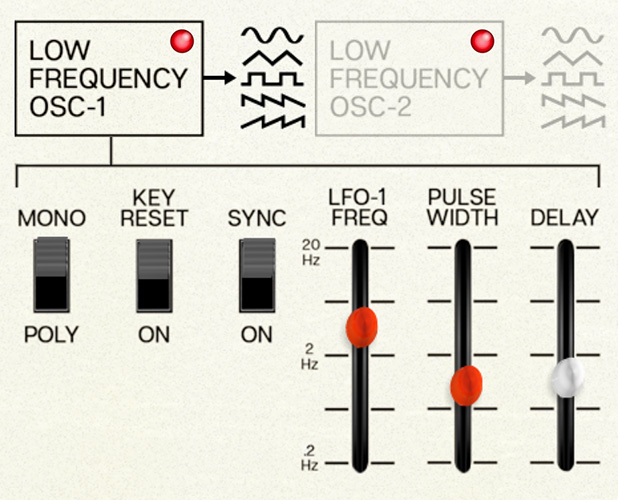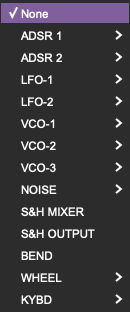In the early years of modular synthesis, designers and artists were divided on the idea of a Low-Frequency Oscillator (LFO). Some felt that it was better to simply have more VCOs that could be used as LFOs when needed, while others preferred the idea of the LFO as a purpose-built modulation source. Both approaches have their merits, but on the "dedicated LFOs rule" side of things, ARP's 2600 and Odyssey were among the first self-contained analog synthesizers to feature LFOs.
The original Odyssey had a single LFO with a single control (LFO Frequency) and sine and square wave outputs. ODC 2800 greatly expands your LFO options by offering two identical LFOs with five output waveforms – sine, triangle, pulse (not square), ramp, and sawtooth. They also include new features, common to analog synths that came along years later, that are much appreciated by today's synthesists.
LFO Select- Click on the labeled box to select which LFO you want to edit. Each box also has an LED that flashes at the current LFO Frequency.
Mono/Poly- This switch becomes important when playing ODC 2800 polyphonically. It lets you choose whether there's a single LFO waveform common to all voices being played, or whether each voice has its own separate LFO that isn't necessarily locked in phase to those on other voices. A Mono setting is good for adding consistent vibrato or trills to melodies and harmonies, while a Poly setting creates a richer and more animated sound for chords.
Key Reset- Sets whether or not the LFO waveform retriggers when a key is pressed.
Sync- Sets whether the LFO Frequency is set in Hertz (Hz; cycles per second) or in bar/beat divisions.
LFO Freq- The rate of the LFO, ranging from 0.2 Hz to 20 Hz, just like the original.
Pulse Width- One of the nice things about using a pulse wave rather than a square is that it can have pulse width control, from extremely narrow/mostly low (5%) through square (50%, the default) to extremely narrow/mostly high (95%). This lets you create syncopations and choppy rhythmic elements.
Delay- Sometimes it's nice for an LFO modulation to gradually get bigger from zero when a note is played. The Delay control lets you set such a delay, from 0.0 to 3.0 seconds.
While ODC 2800 retains the original Odyssey's front-panel sliders and assignment switches for LFO 1 sine or pulse waves, the other waveforms are accessible from the Modulation Source Menu:

